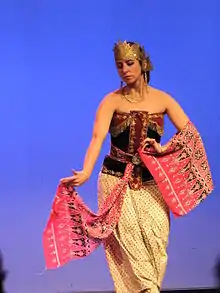Srimpi
The Srimpi (Javanese: ꦱꦿꦶꦩ꧀ꦥꦶ, romanized: Srimpi) (also written as Serimpi) is a ritualised dance of Java, Indonesia, associated with the royal palaces of Yogyakarta and Surakarta. The srimpi dance is one of the classical dances of Central Java.[1][2] Along with the bedhaya, srimpi epitomised the elegant (Javanese: alus) character of the royal Javanese court, becoming a symbol of the ruler's power as well as the refinement of Javanese culture.
 The elegant dance of Srimpi. | |
| Native name | ꦱꦿꦶꦩ꧀ꦥꦶ (Javanese) Tari Srimpi (Indonesian) |
|---|---|
| Genre | Traditional dance |
| Instrument(s) | Gamelan |
| Inventor | Javanese |
| Origin | Indonesia |
| Srimpi |
|---|
|
| Burma |
| Cambodia |
| Indonesia |
|
| Laos |
| Malaysia |
| Philippines |
| Thailand |
|
| Vietnam |
Form and movement
The srimpi dance is usually performed by four female dancers, but other numbers such as two, six or eight dancers are also possible, depending on the type of srimpi being performed. Similarity in looks, height and body type among dancers is preferred to achieve better aesthetics. Srimpi demonstrate soft, slow and graceful movements, highly stylised hand positions, stances and body poses, coupled with the shoulder-baring kemben outfit, to describe elegance, modesty, refinement, beauty and grace. The dancer moves slowly accompanied with serene gamelan music.[3][4]
The srimpi dances, being less sacred in nature than bedhaya, are much better known and often performed, not only in the two Keratons, but also outside the courts for ceremonies and festivals of common Javanese people. Up until today, the srimpi dances are still a part of court ceremonies, as princesses routinely rehearse various types of srimpi in the pendopo pavilion within the palace.
Gallery
 A srimpi dhempel dance performance, choreography by King Pakubuwono VII of Surakarta
A srimpi dhempel dance performance, choreography by King Pakubuwono VII of Surakarta Srimpi dancers of the Regent of Bandung (circa 1864)
Srimpi dancers of the Regent of Bandung (circa 1864) Srimpi dancers in traditional costume in 1900
Srimpi dancers in traditional costume in 1900 A srimpi performance at Yogyakarta Palace in 1885
A srimpi performance at Yogyakarta Palace in 1885 Prince of Mangkunegaran with srimpi dancers in 1885
Prince of Mangkunegaran with srimpi dancers in 1885
Notes
- Hartati, Sri. Seri Panduan Belajar dan Evaluasi Ilmu Pengetahuan Sosial. Jakarta: Grasindo. p. 30.
- A.M. Munardi, dkk (2002). Indonesian Heritage:Seni Pertunjukkan. Jakarta: Buku Antar Bangsa Terjemahan Karsono. pp. 76–77.
- Murtono, Sri (2007). Seni Budaya dan Keterampilan (2nd ed.). Jakarta: Yudhistira. p. 51.
- Paradisa, Gendhis (2009). Ensiklopedia Seni dan Budaya Nusantara (2nd ed.). Jakarta: PT Kawan Pustaka. p. 56.
References
Further reading
- Clara Brakel-Papenhuijzen. Classical Javanese Dance: The Surakarta Tradition and Its Terminology. KITLV Press, Leiden, Netherlands, 1995.
External links
- Video of Serimpi dance in Kraton Yogyakarta on YouTube
- Video of Serimpi Ludira Madu dance in Kraton Surakarta on YouTube
.svg.png.webp)




